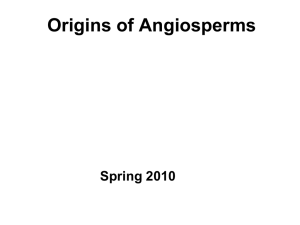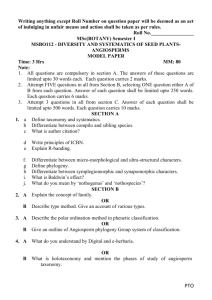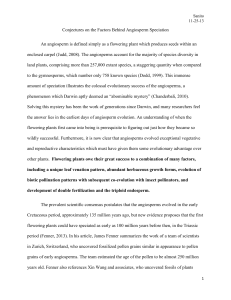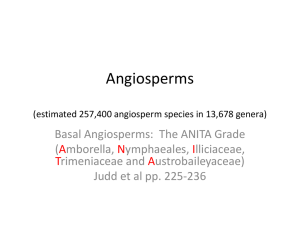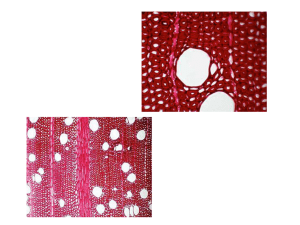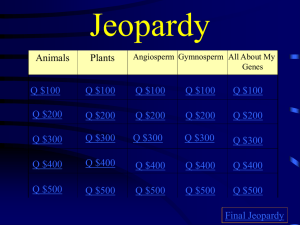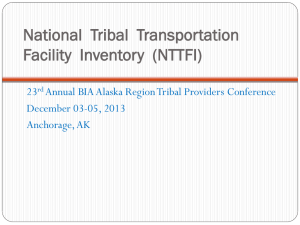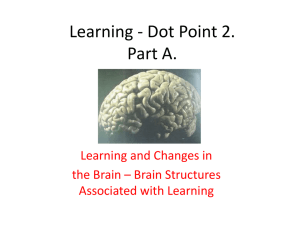Origin of Angiosperms Cycad-like plants
advertisement
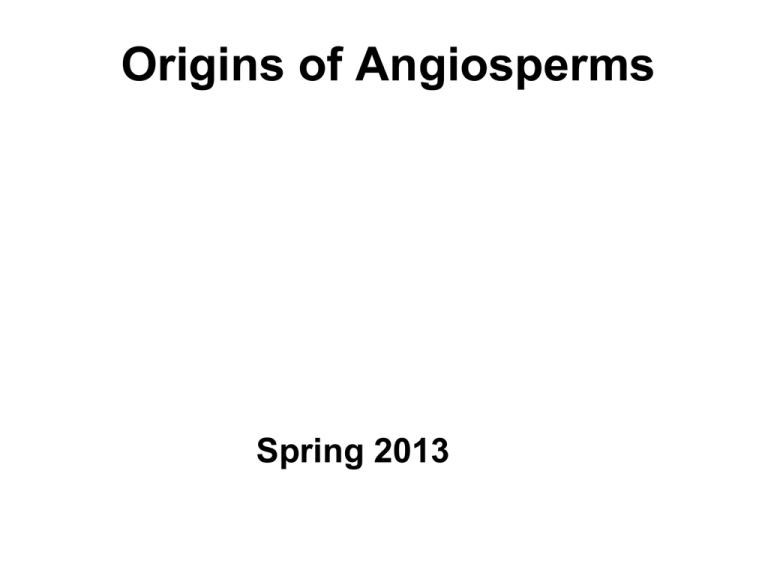
Origins of Angiosperms Spring 2013 Outline • Origin of the angiosperms • Characters of angiosperms • Brief history of angiosperm classification • Major groups of angiosperms • ANITA grade Origin of the Angiosperms Cycads Ginkgo Conifers Gnetophytes Angiosperms Progymnosperms (“seed ferns”) Divergence estimated at ca. 325 mybp Geologic Time Timing of Angiosperm Divergences • The timing of the origin of the • angiosperms still is uncertain, but most would agree on a Triassic or Jurassic initial divergence, although there is no unequivocal fossil evidence A demonstrable “burst” of phylogenetic radiation is found in the fossil record beginning in the mid- to late Cretaceous, 140 - 100 mybp Figure 7.1 Origin of the Angiosperms •pollen grains from ca. 140 mya (early Cretaceous) but already major radiation! •earliest flowers 130 mya •likely no extant group of seed plants is very closely related to the angiosperms! Origin of Angiosperms •Cycad-like plants: Bennettitales? •large, flowerlike strobili: •pollen-producing organs surrounding an axis bearing naked ovules/seeds Origin of Angiosperms Modification of a “seed fern” such as Caytonia? Caytonia fossil: ovule Origin of Angiosperms •Archaefructus •ca. 130 mya •ancestral flowering plant or extinct off-shoot of an extinct lineage? •aquatic plant (dissected leaves) •elongate reproductive axes: -paired stamens below -several-seeded carpels above Characters of Angiosperms Fig. 6.1 What makes a plant an angiosperm? • • • • • • • • Flower (usually with perianth) Carpels with a stigmatic surface for pollen tube germination; ovules enclosed within carpels; fruit Ovules with two integuments Reduced female gametophyte, usually 8 nuclei in 7 cells – no archegonium Double fertilization with the production of 3N endosperm Stamens with two pairs of lateral pollen sacs (microsporangia); pollen (male gametophyte) 3-nucleate Xylem – most with vessels (evolved within angiosperms) Phloem – sieve tube members with 1 or more companion cells derived from the same mother cell Figure 6.2 Flower Magnolia Spiral undifferentiated perianth parts = tepals (plesiomorphic) Magnolia Differentiated sepals and petals (each in whorls) (apomorphic) Abutilon Laminar stamens in basal angiosperms (plesiomorphic) paired pollen sacs connective microsporangium filament Early carpel with stigmatic crest (plesiomorphic)… …to the derived carpel with a style and an apical stigma (apomorphic). Figure 6.9 from the text Female gametophyte in angiosperms -no waiting time as in gymnosperms! -note 2 integuments (bitegmic; some angiosperm lineages have lost one integument) -gymnosperms have mature ovule only 1 integument (unitegmic) ovule And it’s off to the races! Indirect pollination (due to presence of carpels) Seed development in angiosperms -no waiting time as in gymnosperms! double fertilization seed Avocado (Persea, Lauraceae) Flower pericarp exocarp mesocarp endocarp seed fruit Vessels in Angiosperms •are the water (solute) conducting cells of the xylem in most angiosperms •ends of cells have openings (perforation plate), cells shorter and wider •more efficient, faster rate of flow but more susceptible to air bubbles (embolisms) than tracheids are •may have arisen independently in two or more angiosperm lineages but may have had a single origin Origin of vessels from tracheids Figure 6.16B from the text Angiosperm phloem •sieve tube members + companion cells •stm = specialized sugar-conducting cells of the phloem of angiosperms; lack a nucleus at functional maturity •cc = parenchyma cells associated with stm -function to load/unload sugars into stm cavity -derived from the same mother cell as its stm stm Brief history of angiosperm classification Alternative ways of thinking about early angiosperm characters… • • “Old” School (German) - Engler - “Simple is primitive” (Few floral parts) - Ancestors are conifers - Pollination by wind - Modern relicts = “Amentiferae” (catkins) “New” School (American) – Bessey - “Flowers with many parts are primitive” - Ancestors are Cycad-like plants - Pollination by primitive insects - Modern relicts = Magnolias and allies Heinrich Gustav Adolph Engler (1844-1930) -German Botanist at Berlin Botanical Garden -Was the primary European in interpreting the grouping of major angiosperm assemblages -“Few simple flower parts primitive” -Small, unisexual flowers primitive Englerian ‘Primitive Taxa’ Juglans sp. Quercus sp. “Amentiferae” Betula sp. Charles Edwin Bessey (1845-1915) -Botanist at Iowa State University from 1869-1884 (left in 1884 to teach in Nebraska) -Was a “major player” in interpreting and understanding angiosperm evolution -“Many flower parts primitive” Bessey Hall Iowa State University Bessey’s “Cactus” (1915) Placed plant groups with many floral parts in a basal position as the ‘ancestral’ forms. Outlined ‘dicta’ for the construction of phylogenies using the evolutionary trends in character changes. Polypetalous flowers, insect pollination, cycad-like ancestors Besseyan ‘Primitive Taxa’ Nymphaeaceae Magnoliaceae Figure 6.1 from the text Major Groups of Angiosperms • Basal Angiosperms (ANITA grade) • • • - Amborellaceae - Nympheaceae - Illiciaceae Magnoliid Complex - Magnoliales - Piperales - Winterales MONOCOTS EUDICOTS (tricolpates) Major Groups of Eudicots • Basal Eudicots • • • - Ranunculales and allied families Caryophyllales & Saxifragales Rosid Clade - Fabids - Malvids Asterid Clade - Basal Asterids - Lamiids - Campanulids ANITA grade • • • • • Amborella (Amborellales) Nymphaea (Nymphaeales) Illicium (Austrobaileyales) Trimenia (Austrobaileyales) Austrobaileya (Austrobaileyales) Fig. 6.1 ANITA Grade or “basal” angiosperms ca. 125 mybp Grade = a paraphyletic (or Polyphyletic) group whose members share a similar level of morphological or physiological complexity. Major Angiosperm Clades Amborellaceae Nymphaeales Austrobaileyales MAGNOLIID COMPLEX MONOCOTS Soltis et al. 2000, APG II 2002, Judd et al. 2002 EUDICOTS [TRICOLPATES] ANITA grade (basal groups) Basal Angiosperms: Amborellaceae • • • • • • • New Caledonia Understory shrub; plants dioecious 1 species (monotypic): Amborella trichopoda Leaves simple, evergreen Flowers small, unisexual: ♀ apocarpous, with stigmatic crests; ♂ with laminar stamens Significant features: Most basal of all flowering plants; no vessels in wood Special uses: (none) Basal Angiosperms: Amborellaceae (Amborella Family) Amborella trichopoda As we venture through the various major groups of angiosperms… • • • • • Identify the plesiomorphic characteristics associated with particular groups and note their apomorphies (if any) as well. Try to associate “syndromes” of characteristics with each group (make note of special characters occurring together). One good way to study is to write keys to the groups we cover in any given unit. Names of groups are important! Learn to spell and say them! Ask questions!!

